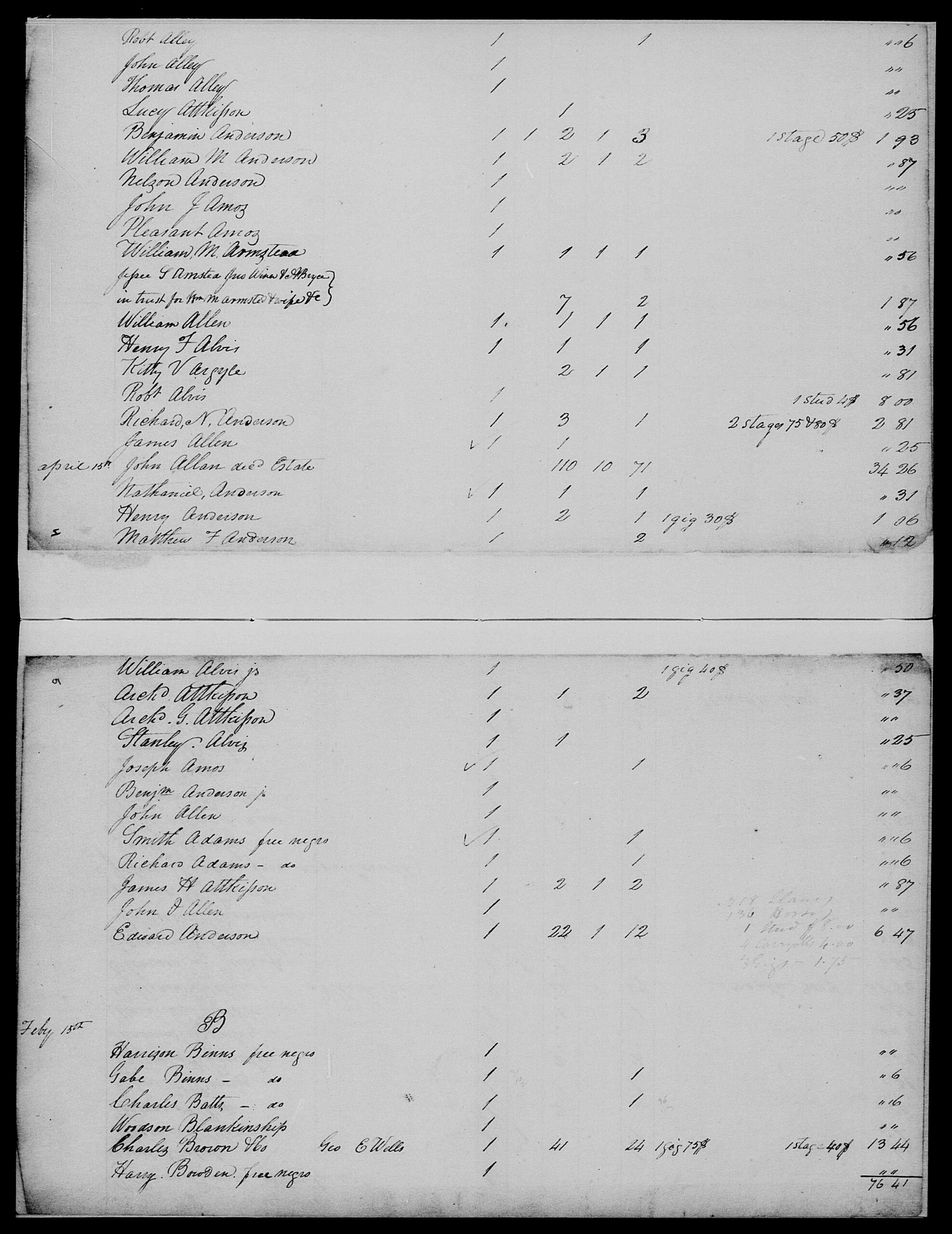Introduction
The land surrounding the fall line of the James River, now known as Richmond, Virginia, has played a pivotal role in this nation’s history. As the ancestral home of the Powhatan Confederacy, the site of Patrick Henry’s “Liberty or Death” speech, and an epicenter of the American Civil War, there is no doubting Richmond’s influence over the major events of U.S. history. Several notable American figures called Richmond their home including Chief Justice John Marshall, Maggie Walker, and perhaps most notably, Edgar Allan Poe.
Edgar Allan Poe, born Edgar Poe, was born to David and Eliza Poe on January 19th, 1809, in Boston, Massachusetts. Poe’s childhood was an unstable one at best. David, Poe’s father, abandoned the family when Edgar was still a baby. When Poe was two years old, Eliza moved her family down to Richmond, Virginia in support of her acting career. By the end of that year Eliza contracted tuberculosis and passed away. At not even three years old, Edgar Poe was orphaned. Thankfully, Frances Valentine Allan, and her husband, John Allan took interest in the young boy and decided to take him into their home as their foster child. Edgar Poe was now Edgar Allan Poe.
The Allans were a well-off, childless couple. Frances was born into the Valentine family, a notable wealthy family of Richmond. John on the other hand, a Scots-man, emigrated to the United States as a teenager to work under his uncle William Galt. While his uncle never provided the liberal education John had envisioned, Allan gained valuable experience as a businessman. As an adult, Allan established his own business with Charles Ellis, aptly named the Ellis & Allan firm. The Richmond-based mercantile business provided Richmonders with various goods including food, clothing, tools, and at times, enslaved individuals.
Growing up in Richmond in the early 19th century, Poe was aware of the presence of slavery within his home and city. Poe grew up in a household where people enslaved by Allan lived and labored. He visited the plantation inherited by his foster father where over a hundred men, women, and children were inherited, bought, and sold. As a young adult in Baltimore, Poe sold Edwin, a man enslaved by his aunt, on her behalf (Matthew Pearl, however, has argued that the document Poe signed freed Edwin while working around Maryland’s strict manumission laws.).[1] When Poe returned to Richmond toward the end of his life, he saw Richmond transform into the second largest slave trading center in the U.S.[2]
While Poe himself never enslaved anyone, he was raised in a household which profited from the institution of race-based slavery. To have a complete understanding of Poe’s life and upbringing in Richmond an understanding of the lives of those individuals enslaved by his foster father is required. Poe and Allan’s lives, like many middle and upper-class individuals in Richmond, were supported through the institution of slavery to some degree. Not only does this ongoing research deepen the historic knowledge of Poe’s life, but it broadens the understanding of slavery in Richmond and the individual histories of the enslaved.
Research on these individuals was collected through tax records, wills, newspaper accounts, deeds, letters, census records, court documents and other valuable databases. While new information has been found, the records of these individuals are still limited. Most sources do not list names, and only supply the number of enslaved individuals within a household. In rarer cases, first names such as Judith, Henry, and Scipio appear. However, these cases provide no information about the forced responsibilities these people performed, their families, or their memories.
This research temporally covers references to individuals enslaved by John Allan from 1811, when Edgar Poe joined the Allan family, to 1834 when John Allan passed. Geographically, this research spans the City of Richmond, located in Henrico County at this time, and Goochland County, focusing on those enslaved in urban domestic households owned by Allan, his Richmond business ventures, and his rural plantation. The lives of those enslaved in urban centers like Richmond differed from those in rural plantations. By the time Poe was a teenager in Richmond, the population of the city consisted of 6,500 free white individuals, 4,300 enslaved individuals, and 1,200 free black individuals.[3] Enslaved individuals laboring in urban domestic households often performed multiple forced duties rather than one specific skill or labor. Additionally, enslaved individuals often slept near the labor they performed, both in outbuildings and within the main house, rather than having separate living quarters.
This paper will provide contextual information of the lives of other individuals enslaved in Richmond to infer what those living on Allan’s properties likely experienced. This paper will be continually updated as more information of the narratives of these individuals is discovered.
13th St. & Main and 14th St. and Tobacco Alley, Richmond City, VA
Edgar Allan Poe called several places home throughout his childhood and adulthood. When he was first taken in by the Allans, the family lived at 13th Street and Main, right above the Ellis & Allan firm. The small home housed not only Frances, John, and Edgar, but also Frances’ sister Nancy, and Judith, a woman enslaved by John Allan. Judith is first recorded in John Allan and Charles Ellis’ papers on January 1st, 1811, a year before Edgar was taken in by the family.
“Jan. 1st, 1811, a negro woman named Judith hired from Master Cheatham for the sum of £25 to be retained clothed as usual under a bond of £50.”[4]
Not much is currently known of Judith’s life, forced responsibilities, or family. She likely labored throughout the home, caring for young Poe, cooking meals in the outdoor kitchen, or smoking meats in the smokehouse.[5] Through the historical record we know she likely stayed with the Allan’s for quite some time. The 1820 census lists only one enslaved individual in the Allan household, a woman of at least 45 years of age.[6] Assuming this individual is in fact Judith, then it follows that she was first enslaved by Allan in her mid-30’s.
Edgar lived at 13th and Main until the age of 6. In 1815 the family moved to England for five years for Allan to expand his business. When those business ventures ultimately failed, the Allans returned home to Richmond and moved into the home of Allan’s business partner Charles Ellis at 2nd and Franklin Street for about six months before relocating to a house on 5th Street, between Marshall and Clay Streets, where they resided until May 1822. The family next moved to a house on the corner of 14th street and Tobacco Alley, where Poe lived from 13-16 years of age (1822-1825). This home was located one block away from the 15th street business district—Richmond’s slave trading district.
The Ellis and Allan Firm
Slave trading, in addition to the industries of flour and coal, was one of Richmond’s main sources of economic development in the early 19th century. While slave trading existed in Richmond prior to the 1830s, during the 1830s-1860s, Richmond became the largest slave trafficking center in Virginia, and the second largest in the country. Enslaved individuals, brought by boat up the James River, were traded in Richmond in hotels, auction houses, and jails which lined Shockoe Bottom from the river to Broad Street.[7] While some individuals were bought by Richmond enslavers, many were traded to deep south plantations. These experiences are best described by the individuals themselves.
“At Fredericksburgh we were transferred from the stage coach to a car, and before dark arrived in Richmond, the chief city of Virginia. At this city we were taken from the cars, and driven through the street to a slave pen, between the railroad depot and the river, kept by a Mr. Goodin. This pen is similar to Williams’ in Washington, except it is somewhat larger; and besides, there were two small houses standing at opposite corners within the yard. These houses are usually found within slave yards, being used as rooms for the examination of human chattels by purchasers before concluding a bargain.”[8]
Solomon Northup, Twelve Years a Slave
The Ellis & Allan firm participated in slave trading in several different capacities. In October 1811, prior to Allan taking in Edgar, Allan participated in the auction of “a Negro man about 28 years of age, and a Negro woman about 26 years of age” as well as a tract of land on the behalf of James Pleasants to settle the debt of Phillip Pleasants.[9] In 1812, the firm, acted as a lender of “542 Acres and the following slaves Andrew Anthony Bob Betsy and child, Lucy and children Sally & Children” to William Dandridge.[10] In 1815, Ellis, acting on the request of Allan, sold Scipio, an enslaved man, for $600, and hired out an unknown number of other enslaved individuals for $50 per person.[11] Enslaved individuals, especially in urban settings, were often hired out to other enslavers or employers who would contractually lease them.
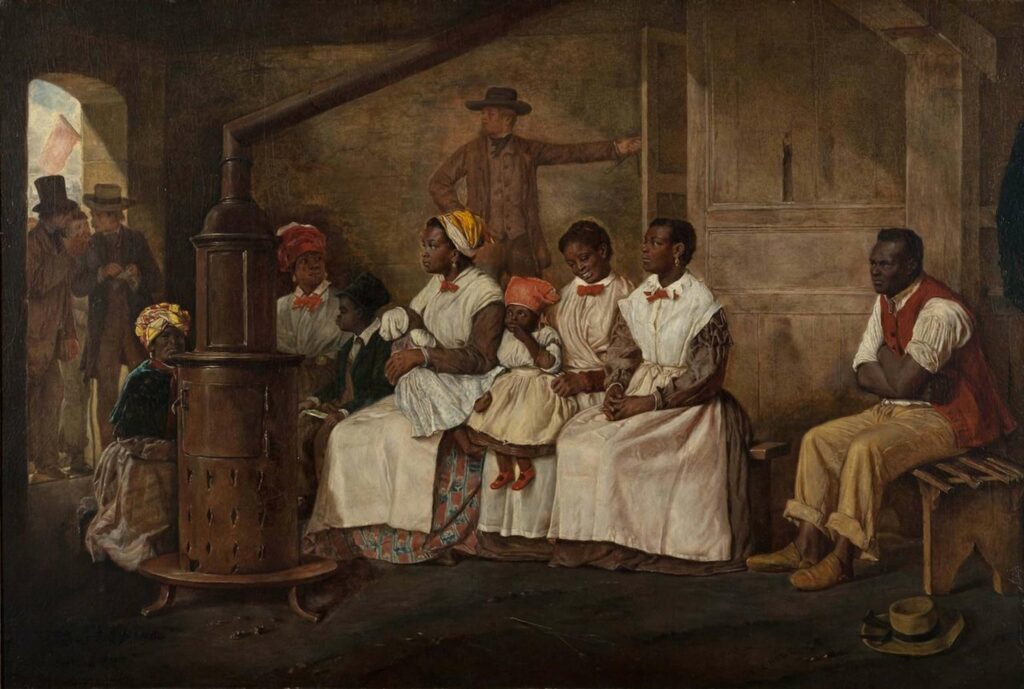
Slaves Awaiting Sale, Richmond, VA, by Eyre Crowe (1861) Heinz Family Collection.
Not only do these sources provide insight into the business’ involvement with slave trading, but they also illuminate the experiences of enslaved individuals in the 19th century. Enslaved individuals were often sold alongside purchasable items such as food, tools, clothes, or land etc. as they were considered goods—items to be bought, leased, sold, invested in, rather than humans with individual agency. While these sources are a glimpse into the economic ventures of slave trading by Ellis & Allan, research is still ongoing to discover the firm’s extent of involvement into the slave trade.
Moldavia, 5th and Main St., Richmond City, VA
1825 was a transformative year for Allan and his slaveholdings. William Galt, Allan’s uncle and one of the wealthiest men in Richmond, passed away, leaving Allan a hefty portion of his fortune. This inheritance propelled Allan’s wealth and status in Richmond. Shortly thereafter, Allan purchased a new home for his family at 5th and Main St. named Moldavia. Moldavia was a physical representation of Allan’s increased wealth, which included a large 2 1/2 story home, icehouse, green house, stables, and servant’s room.[12] Allan’s increased wealth also led to an increase in the number of people enslaved within his home.
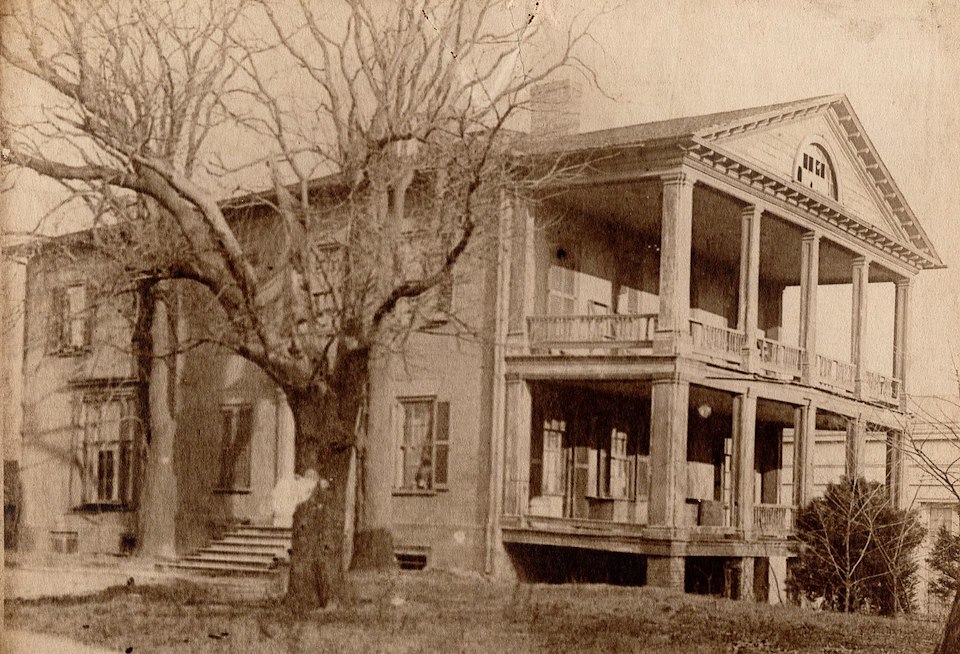
The 1830 Census lists 13 unnamed enslaved individuals in Moldavia in addition to the Allans[13]. Of these 13 individuals, 3 were children under 10 years old (two boys and one girl). These children were only a few years younger than Edgar. Enslaved children often had the forced responsibilities of tasks like carrying buckets of water or drying clothes.[14] It is uncertain whether the individuals enslaved by Allan were part of family units, and whether or not Allan maintained those units. In his uncle’s will, of whom Allan was an executor of, Galt requested that family units of those he enslaved be kept together.[15] Enslaved families were constantly under threat of being sold off and separated, especially during periods of economic hardship.”
Others listed at Moldavia in the 1830 census included 2 young adult men, 4 adult men, and 4 adult women. Again, the names and labors of these individuals are unknown, however, insurance plats and collection items from the Poe Museum’s collection can help piece together their narratives. Within the home, enslaved individuals likely served food, washed and ironed linens, cleaned and heated fireplaces, polished silver, and emptied chamber pots, in addition to other forced responsibilities. Today, many of the objects preserved from Moldavia, such as the Allans’ irons, salt cellars, decanters, and China, represent the forced labor of those who interacted with these objects daily.
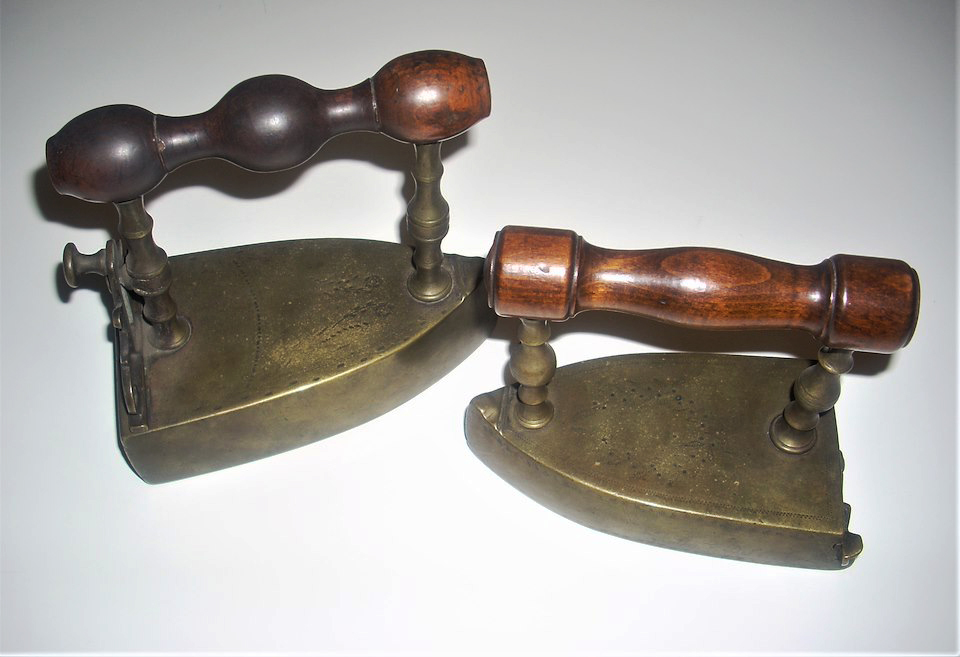
Outside of the main house, enslaved labor continued in the gardens, basement, icehouse, and stables. An insurance plat in 1829 shows an attached brick wing of Moldavia labeled “Servants Room.” Some, if not all, of those enslaved at Moldavia may have slept here on wooden pallets with wool covers. Privacy for those enslaved at Moldavia would have been rare with little room to keep personal belongings.[16] No material culture belonging to those who labored at Moldavia is preserved today.
In addition to the 13 individuals who were enslaved at Moldavia, it appears Allan also hired a freed man Bellmour (sometimes spelled Belmour) Johnson. Johnson was formerly enslaved by William Galt until his death. Upon the death of Galt, Johnson was manumitted and given forty dollars as stipulated in Galt’s will.[17] Shortly thereafter, it appears Allan hired Johnson as a carriage driver and hustler. Moldavia’s census records indicated no freed males living at Moldavia, so it is likely Johnson lived elsewhere in the city, perhaps in one of the several free black communities in Richmond.[18] In 1831, Allan, amongst many other prominent Richmonders, petitioned for Johnson to remain in the state of Virginia with his unnamed wife and children. In 1806, “An ACT to amend the several laws concerning slaves” was passed by the Virginia General Assembly which stated that any person freed in Virginia must leave the state within 12 months.[19] This legislation was a direct response to several freed black uprisings, including Gabriel’s conspiracy. Allan petitioned on behalf of Johnson, remarking on his character.
“While he has lived with me as a Driver & Hustler his conduct has been excellent; on one occassion his readiness, courage & Sense saved my Family from the most eminent danger in crossing the Warm Spring Mountain, before it was a Turnpike. In a more recent instance my Horses took Fright (with Mrs Allan in the carriage) His great presence of mind again saved his Mistress; probably her life. If any consideration can weigh to allow an emancipated Slave to remain in the State wherein his wife & children Live might I hope that it may be extended to such men as Belmour Johnson”[20]
While it is unknown if Johnson’s petition was successful, it does highlight the difficulties freed men and women experienced after manumission—the threat of having to leave the state where your family and children live, finding housing, and making sufficient wages.
Poe only briefly lived in Moldavia before attending the University of Virginia in 1826. During that time, he would have been intimately acquainted with the functions of enslavement and forced labor in his foster father’s household. In an 1827 letter to Allan, Poe expressed his disdain for Allan’s lack of financial care and empathy. Poe concludes the letter by proclaiming to Allan “You suffer me to be subjected to the whims & caprice, not only of your white family, but the complete authority of the blacks — these grievances I could not submit to.”[21]
Byrd Creek Plantation, Goochland County
In addition to receiving enough inheritance to purchase Moldavia, Allan also inherited from Galt “…three landed estates, named the ‘Byrd,’ lying and being situate in the Counties of Goochland and Fluvanna, on the Byrd Creek, with the slaves, stocks and property of all kinds belonging thereto;”[22] The Byrd plantation, located 50 miles west of Richmond, was around 6,000 acres and reported to be worth $70,000 according to Poe.[23]
According to personal property tax records, Allan initially inherited 92 individuals above the age of 12 in 1826.[24] By 1834, the year of his death, he acquired 110 individuals above 16 years of age, and 10 individuals between 12 and 16 years of age.[25] Distinctions of those above and below 16 years of age were made in tax records because any enslaved individual 16 years of age and above was considered tithable, or a taxable adult, and therefore performing the mental and physical labor expected of enslaved adults.[26]
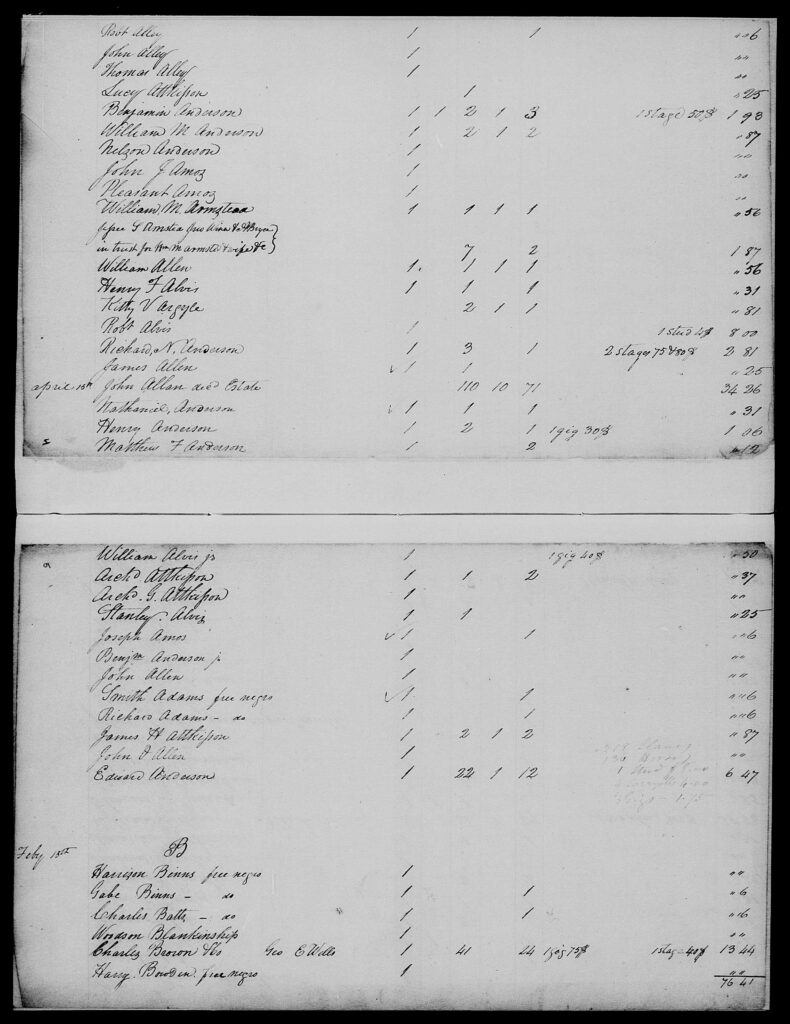
One of these individuals at the Byrd plantation was named Henry. On November 8th, 1839, Henry, who was at that point enslaved by Allan’s second wife Louisa G. Allan, was brought to court over the murder of Isham Cheatham[27]. Witnesses claimed Henry murdered Isham Cheatham on October 26th, 1839, on the Byrd plantation. While Henry pleaded not guilty, the jury ultimately found him guilty of murder and sentenced him to hang on December 20th of that year.[28]
In addition to enslaving over a hundred individuals on his own plantation, Allan continued to sell men, women, and children in rural counties as the executor of Galt’s will. Allan advertised the sale of Galt’s enslaved individuals in the Constitutional Whig, stating “Also be sold at the same time and place, all of the negroes attached to said being about 60 in number, among them are four valuable coopers; the balance excellent field hands, including men, women, and children… JOHN ALLAN & WM. GALT} Executors of Wm. Galt dec.”[29]
After Allan’s death, the people he enslaved at Moldavia and The Byrd plantation were inherited by his second wife, Louisa G. Allan. It appears Mrs. Allan sold many individuals after her husband’s death, perhaps to support her and her legitimate children. The fate of these individuals and their descendants today is unknown.
While many facets and intricate details of Poe’s life are closely studied, the totality of his foster father’s slaveholdings in Virginia is yet to be fully understood. The goal of the Poe Museum’s ongoing research is to uncover and publish the historical narratives of Judith, Scipio, Henry, and the hundreds of unnamed individuals enslaved by John Allan to ensure their histories are remembered. This research was conducted by Emma Clark, Education Manager at the Poe Museum, Chris Semtner, Curator at the Poe Museum, and Anna Jones. If you would like to volunteer to aid in this research, please contact Chris Semtner and Emma Clark.
[1] Bill of sale for Negro slave named Edwin sold by Edgar A. Poe, agent for Maria Clemm, to Henry Ridgway, December 10, 1829, recorded December 29, 1829, Enoch Pratt Free Library / State Library Resource Center. https://collections.digitalmaryland.org/digital/collection/poe/id/174/rec/1
[2] For more information see https://savingplaces.org/places/shockoe-bottom#:~:text=Richmond’s%20slave%20trade%20industry%20was,flowing%20into%20the%20James%20River.
[3] McGraw, M. T. (1987). Richmond Free Blacks and African Colonization, 1816-1832. Journal of American Studies, 21(2), 207–224. http://www.jstor.org/stable/27554832
[4] Allan, John to Charles Ellis. January 1st, 1811. Ellis & Allan Company records, 1795-1889, Library of Congress.
[5] September 4th, 1818 Mutual Assurance Plat, Mutual Assurance Society of Virginia.; Library of Virginia https://image.lva.virginia.gov/cgi-bin/drawer?retrieve_image=MU&offset=-2498&include=&policy=2583&reel=010
[6] 1820 U.S. Census, Richmond, Henrico, Virginia, United States, Richmond (Independent City), Virginia, United States, pg. 167, M33, The U.S. National Archives and Records Administration (NARA) https://www.familysearch.org/ark:/61903/3:1:33S7-9YYY-R1S?view=index&action=view
[7] Mapping Richmond’s Slave Market, Digital Scholarship Lab, University of Richmond, 2010. https://dsl.richmond.edu/civilwar/slavemarket.html
[8] Northup, Solomon. (1853). Twelve Years A Slave. Narrative Of Solomon Northup, A Citizen Of New-York, Kidnapped In Washington City In 1841 And Rescued In 1853, From A Cotton Plantation Near The Red River in Louisiana (pp. 58).
[9] The Enquirer, Volume 8, Number 44, 8 October 1811, The Virginia Chronicle, Chronicling America: Historic American Newspapers. Lib. of Congress. https://chroniclingamerica.loc.gov/lccn/sn84024736/1811-10-08/ed-1/seq-4/
[10] Andrew, etc.: Deed, 1812 (7800733_0008_0009). Virginia Untold: The African American Narrative Digital Collection, Library of Virginia, Richmond, Va., http://rosetta.virginiamemory.com:1801/delivery/DeliveryManagerServlet?dps_pid=IE3602147
[11] John Allan to Charles Ellis, June 22nd, 1815. Letter.
[12] December 15th, 1829, Mutual Assurance Society Insurance Plat of Moldavia, Mutual Assurance Society of Virginia. Library of Virginia Declarations. Vol. 89, Reel no. 13. https://image.lva.virginia.gov/cgi- bin/drawer?retrieve_image=MU&offset=-6394&include=&policy=6731&reel=013
[13] 1830 U.S. Census, Richmond, Henrico, Virginia, United States, Richmond Monroe Ward, Richmond (Independent City), Virginia, United States, pg. 369, M19, The U.S. National Archives and Records Administration (NARA) https://www.familysearch.org/ark:/61903/1:1:XH5N-QQS
[14] For more information see https://www.monticello.org/slavery/slavery-faqs/work/
[15] Last Will and Testament of William Galt, 1835. Found in Hervey Allen, “Appendix 03,” Israfel: The Life and Times of Edgar Allan Poe (1926), volume 2, pp. 857-873. https://www.eapoe.org/papers/misc1921/hva262a3.htm
[16] Dean, Catherine E. (2010). Beds. In Martha B. Katz-Hyman, Kym Rice (Eds.), World of a Slave: Encyclopedia of the Material Life of Slaves in the United States (pp. 54-57). Takagi, Midori. (2000). Rearing Wolves to our Own Destruction: Slavery in Richmond Virginia, 1782–1865, (pp. 39-40).
[17] Last Will and Testament of William Galt, 1835. Found in Hervey Allen, “Appendix 03,” Israfel: The Life and Times of Edgar Allan Poe (1926), volume 2, pp. 857-873. https://www.eapoe.org/papers/misc1921/hva262a3.htm
[18] McGraw, M. T. (1987). Richmond Free Blacks and African Colonization, 1816-1832. Journal of American Studies, 21(2), 207–224. http://www.jstor.org/stable/27554832
[19] General Assembly. “An ACT to amend the several laws concerning slaves” (1806). (2020, December 07). In Encyclopedia Virginia. https://encyclopediavirginia.org/entries/an-act-to-amend-the-several-laws-concerning-slaves-1806.
[20] Johnson, Bellmour : Petition to Remain in the Commonwealth, Richmond City, 1831, Richmond (Va.) Free Negro and Slave Records, 1827-1865 (bulk 1861-1865), Library of Virginia, http://rosetta.virginiamemory.com:1801/delivery/DeliveryManagerServlet?dps_pid=IE3427758
[21] Edgar Allan Poe to John Allan — March 19, 1827, Poe, Allan, Ellis Papers, 1803-1881. MSC0033. The Valentine, Richmond, Virginia.
[22] Last Will and Testament of William Galt, 1835. Found in Hervey Allen, “Appendix 03,” Israfel: The Life and Times of Edgar Allan Poe (1926), volume 2, pp. 857-873. https://www.eapoe.org/papers/misc1921/hva262a3.htm
[23] Edgar Allan Poe to William Poe — August 20, 1835. https://www.eapoe.org/works/letters/p3508200.htm#:~:text=Text%3A%20Edgar%20Allan%20Poe%20to,%2C%201835%20(LTR%2D047)&text=Dear%20Sir%2C,knowing%20precisely%20in%20what%20manner.
[24] Personal Property Tax of Goochland County, 1826. Family Search https://www.familysearch.org/ark:/61903/3:1:3Q9M-CSKJ-49MR-H?i=650&cat=407328
[25] Personal Property Tax of Goochland County, 1834. Family Search https://www.familysearch.org/ark:/61903/3:1:3Q9M-CSKJ-73TR-Q?i=49&cat=407328
[26] For more information see https://lva-virginia.libguides.com/tithables#:~:text=In%20seventeenth%2D%20and%20eighteenth%2Dcentury,civil%20government%20in%20the%20colony.
[27] This may or may not be the same Isham Cheatham who hired Judith to John Allan.
[28] Allan, John, Estate of : Public Claim. May 19th, 1840, Condemned slaves and free blacks executed or transported records, 1781-1865, Accession APA 756, Box 3, Folder 20, Virginia Untold: The African American Narrative, Library of Virginia. http://rosetta.virginiamemory.com:1801/delivery/DeliveryManagerServlet?dps_pid=IE1182400
[29] Constitutional Whig, Volume 4, Number 72, 6 October 1827. Library of Virginia, Virginia Chronicle. https://virginiachronicle.com/?a=d&d=CH18271006.1.4&srpos=11&e=——182-en-20–1–txt-txIN-%22john+allan%22+——-Richmond%2c+VA

